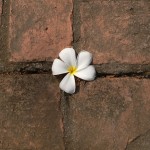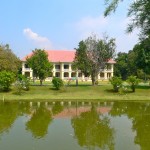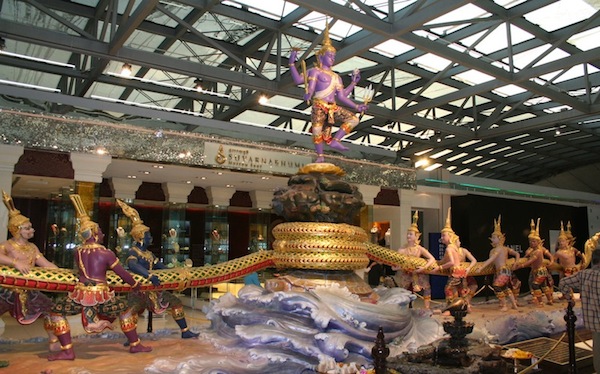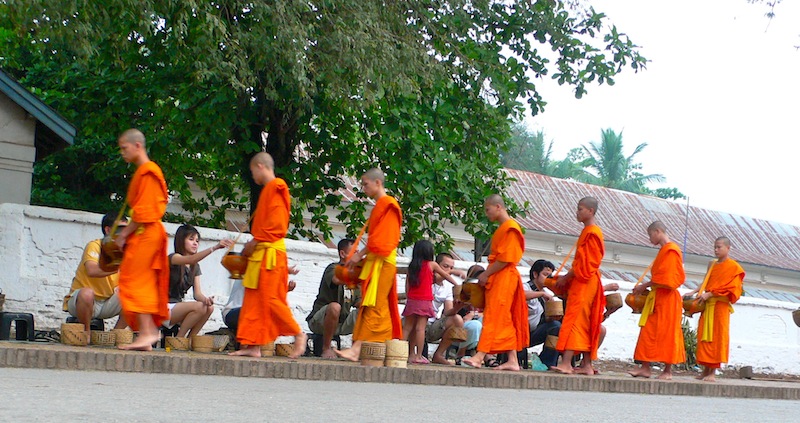Saying Goodbye In Thai
Mean Streets, Peaceful River
by Larry Calloway (c) 2012
In the new Bangkok air terminal a long sculpture on the way to international departures depicts a tug of war, demigods v. devils, in the clean bright primary colors of Theravada Buddhist temples. This moral chemistry, this dynamic equilibrium of unresolved issues that has gone on since the beginning is a fine Hindu creation myth.
In this story, “Churning the Ocean of Milk,” the Asuras and Devas pull back and forth on a rope hitched around a spindle. (The rope is a mythological snake, the spindle is a sacred mountain, and the winners will get immortality if they last, but we’ll never know.) From the disturbance of the Milky Way came a number of things, depending on the version. The version in my Western eyes as I departed – perhaps finally – was cosmic. It was creation via the slightest first tick of information in the ocean of Zen Emptiness, like Milton’s Satan crossing Chaos and leaving a track from which all organization evolved. The sculpture also is Thailand, where the nightclubs are as famous as the temples (and a whore would never touch a monk) and yellow shirts and red shirts hold staggered demonstrations and democracy alternates with military dictatorship and committees on national reconciliation don’t reconcile. Whatever, the reciprocating engine produces something wonderful like . . . life.
Except for the creationist sculpture, the new airport terminal could be anywhere. It is novel – facades of plate glass and stainless steel under tent tops. It is impressive – 6 million square feet on a steaming plain 20 miles from the city. It is coherent – a single project completed in 2005. But it could be Hong Kong or Beijing or Dubai, equally large. There is a kingdom of airports in the world. You could get stamped in to dozens of nations around it and never leave one. Ram Dass said – and it was a teaching – that every air terminal has posters for somewhere else.
The 600-room Novotel, with a lobby high as a cathedral, was built along with the terminal. I have stayed in this hotel several times to make overnight flight connections. In the city there’s a spread of places to stay: tall luxury hotels on the river Chao Phraya, international franchises at Silom Road, backpacker havens at Khao San Road. But overnighting in the city involves the risk of missing a flight next day due to the uncertainty of Bangkok traffic. Another annoyance is that taxi drivers will pimp a farang traveling alone and wanting only to wake up on time. (“You want see the girls?” “Mai Chai. Pai Holiday Inn, khrab.” “Why not? You like boys?” “Hotel is all, sir.”) For the same reasons, traffic gridlock and pimping taxi drivers, I learned long ago to do my Bangkok sightseeing by boat, the cheap regular daytime public transportation on the Chao Phraya.
On April 10, 2010 I checked in to the Novotel with my longtime traveling partner after two weeks in pure and happy Bhutan. We were directed to take the back way to our room. After the luggage arrived, she went to the jungley pool and I went to the lobby for a newspaper to catch up on the demonstrating red shirts. Returning I headed for the main elevators and was stopped by a hotel security man. “No. No. Other way.” I turned to the stairs. “No. No.” He pointed down a long hall, the way I had come down. “Other way.” I did not understand this, but I complied. In Thailand some things go unexplained, even in the humming modernism of Suvarnabhoumi airport and its hotel.
That evening when we went down, by the back way, for dinner we had an explanation. The restaurant was crowded with men in uniform, officers of the Thai armed forces. They sat at tables in small groups, eating well and talking quietly. They had taken over a wing of the hotel. I supposed it had something to do with the trouble in the city.
The red shirts had been camped downtown for two months and the military government was losing patience. I had seen the beginning of it in March, when I was staying at a wat near Fang, north of Chiang Mai. (Wat translates as “temple,” but the word applies to any religious complex, from the rich royal temple grounds in Bangkok to humble village centers.) On a Friday morning I had watched at the highway as cars and trucks full of protesters waving red flags streamed by. They were on their way to the “Million Man March” in Bangkok. I was in the north, where almost everybody was a red shirt, as opposed to the yellow shirts of Bangkok and the southern resort towns. The only yellow displays I saw in the north were banners at government compounds.

These northerners were ordinary people who worked hard and kept their kids in school, but they were poor by comparison with the Bangkok factory workers and those in the tourist trade. Still, they were Thai, and like the rich southerners they respected the king and the Buddha and sometimes the military. On Sundays in the sala, a spacious pavilion dominated by a single whitefigure of the seated Buddha in tranquil meditation, whole families would gather with food baskets and spend the day, singing the Pali sutras and listening to dharma talks by the young abbot or his senior monks.

Theravada Buddhism is practiced in Southeast Asia and Sri Lanka. Under the non-democratic regimes of Burma, Laos and Cambodia, the monks in saffron robes are constantly watched, but they are embraced under Thailand’s constitutional (when not suspended) monarchy. Theravada (sometimes translated as wisdom of the elders) differs from the Mahayana (meaning larger vehicle) tradition of China, Japan, Tibet and Vietnam. The Theravada dharma is a back-to-the-sources teaching in the ancient Indian language called Pali. It does not rely upon latter-day sacred texts or venerate bodhisattvas like Avalokitesvara. The Theravada altars are simple venerations of the Buddha.
As Buddhism unites Thailand, politics divides it, north from south, rural from urban, the interests of poor farmers and the immigrants along the Lao border from those of the wealthy royalist families of Bangkok. The north was the solid constituency of Shinawatra Thaksin, the telecom billionaire and twice-elected prime minister who served from 2001 until he was overthrown in a military coup in 2006. (His younger sister was elected prime minister in 2011.) Thaksin’s party, by various names, provided development money and medical care to the poor and was rewarded by the voters in the northern region called the issan. He went into exile after being charged with corruption by the supreme court under the military government.
Now, in the spring of 2010, the red shirts were demanding an election, promised for four years by the military government. In a strange and gruesome display, they emptied bags of their donated blood at the gates of Government House. There had been confrontations with police and army surrounding the camp at Phan Fa Bridge, but both sides seemed to show restraint.

MEAN STREETS
As we dined among the quiet officers and talked of where we had been and where we were going next, soldiers and police were moving to clear the protesters downtown. The state TV channels were rerunning game shows. An objective report of the clashes that spring by Human Rights Watch, an American group, tells how on the morning of that day, April 10, the military-appointed prime minister had announced an order to clear the protesters. In the afternoon the army, under helicopters spraying tear gas, moved against 5,000 red shirts bearing pointed bamboo sticks at Phan Fa Bridge, which crosses a canal in the neighborhood of government buildings and Khao San Road. The wind shifted, carrying a cloud of tear gas back on the soldiers. They retreated. Protesters approached in the heat and gave the soldiers water, according to a news reporter quoted in the report.

That night at Khao San Road there was shooting – from both sides. The report found that armed men in black had joined the red shirts and were firing live ammunition. The soldiers too were firing, some with rubber bullets, some not. The fighting spilled to other areas including the upscale World shopping mall. An army commander was killed by a grenade. A Reuters photographer died from a gunshot wound in the chest. After two hours of fighting the army retreated. The day ended in a standoff. Human Rights Watch published these numbers for the day: 26 dead including 5 soldiers, 800 wounded including 350 soldiers. According to autopsy reports, most deaths were by high velocity bullets.
We flew away early next morning, knowing nothing and never having left the safe, insular, humming modernity of the airport, a monument to 50 years of incredible development. It was named Suvarnabhumi, “Golden Land,” by King Bhumipol.
On the way south I replayed impressions from three trips through Thailand and Laos, and what shined brightest were those fresh mornings in Luang Prabang, Laos, a United Nations world heritage site. Hundreds of barefoot monks in bright saffron file down the sunny side of the central avenue of the narrow peninsular town at 6 a.m. (Tourists with cameras work the other side.) Townspeople and merchants drop small parcels of food – sticky rice, packaged noodles, cakes and such – into the brass bowls. The monks receive the gifts impassively and walk on. It’s the givers instead who express gratitude, putting their palms together, because they are earning merit under the inexorable law of karma. (In the 2007 protests in Yangoon, Burmese monks turned their begging bowls upside down.)
The meritorious giving takes place everywhere in the Theravada Buddhist countries. Monks walk the beaches at dawn in southern Thai resorts. They appear at shops beside noisy highways or among village stalls in the issan. On some mornings at the wat near Fang I would follow Joi, the bright young monk who had unceremoniously shaved my head and eyebrows for ordination as a novice. He would stand alone with his bowl in the dimly lit early morning market, impassive but thoughtful as shoppers gathering food for the day would drop gifts in his bowl.
Joi was from a village of people who had escaped Burma. They are Palaung, a million-member ethic minority that was virtually at war with the Burmese army. Most refugees, from Cambodia and Laos as well as from Burma, go officially unrecognized by Thailand, so they have no country and, therefore, no actual workable rights (I follow Hannah Arendt on this point) . It seemed to me that this young man’s only protection was the universal Thai respect for his saffron robe. He had just received his high school diploma, was fluent in English and Thai and aspired to learn Chinese so he could teach in the region, which has communities of earlier refugees, nationalists from China.
Joi was preoccupied. If he left the order, replacing his robe with civilian clothes, he would be vulnerable. But it was the only way to enter the private college in Chiang Mai and pursue courses in Chinese. If he continued as a monk, he would receive a free Buddhist education but the foreign language study would be limited to English. I learned later by Facebook that he chose Chinese.
A small regional NGO called the Blood Foundation operates day-care schools for children of Burmese refugees, many of whom work in the orange groves in the Fang area. One evening we arrived by pickup at Joi’s village in the mountains on the border where army outposts of both Burma and Thailand face each other across a no-man’s land of barbed wire. The Burmese army could watch every move in the village and once shelled it after some sort of altercation, but the people were carrying on with their lives without fear. They sat in family circles eating the evening meal in porous bamboo houses.
The abbot at the wat was Dr. Apisit (PhD from a Buddhist University), a gentle and compassionate young man who kept two beloved monkeys as pets. His remarks to me at my ordination forewarned that the four weeks were not going to be a

holiday.Besides accepting the universal Buddhist precepts and seeking refuge in the Buddha, dharma and sangha, I also pledged to take no food after noon, sleep on a hard bench, wear nothing decorative and avoid trivial conversation. Dressed in white and without hair or eyebrows, I had trouble recognizing myself in digital photos. Which was the point. All this, the abbot counseled, was intended to aid the practice: vipassana meditation.
The village and neighborhood wats are schools for boys whose families choose traditional Buddhist education, often because they cannot afford any other. They live simply and (allowing for their nature as boys) quietly. They sweep the grounds thoughtfully. They chant mornings and evenings in their sanctuaries.
But mere monastic quietude does not define the fullness of Theravada Buddhism, at least in Thailand. Dr. Apsit carried a cell phone and was in the process of buying farmland around the wat for expansion – a retreat center for Westerners, a hospital. The director of the wat school one evening invited me and another in white (who took the vows but because of her gender could not become a novice monk) to come with him in his small pickup to an event marking the completion of renovation work at a wat down the highway. As we approached it I was surprised that he had trouble finding a place to park.
Inside the gates, the old wat was – excuse the cliché – rocking! There was a rock band playing. There was a stage where Thai “lady boys” sang like girls. There were dance groups in colorful ethnic costumes. The lights were so bright the power kept going out. There were lines of delicious food vendors. (Ignoring them was a test of my vows). And then came the parade of “money trees.” Coughing up a donation is nothing compared with the work that goes into these ornate constructions by community groups, businesses and families. The focus of these gifts is the leaves: crisp new Thai 100-bhat bills (as valued locally as $20 bills here)
I had seen a similar celebration, wealthier but no less communal, at my favorite town in Thailand: Nakhorn Pathom near Bangkok, the site of a 427-foot stupa built in the late 19thCentury by Mongkut, the beloved king who had spent most of his adult life as a monk. A standing golden Buddha with his right hand raised in peace surveys a busy commercial center. Here the celebration included a parade of school bands and cheerleaders and lovely queens and dignitaries in new Japanese cars

assembled in Thailand. The fiesta (and I use the Spanish-Catholic word deliberately) in Nakhorn Pathom celebrated Loi Kratong, the full moon in November. All full moon days are Buddhist holidays, but this one is special in Thailand because of the tradition of floating little wish lights on water. Elsewhere, on the southern beaches, and on the other hand, full moon holidays bring orgiastic revels by young Western tourists. The churning of the ocean perseveres.
GRIM REMINDER
What you see leaving Bangkok, more than the freeways and flats of sterile rooftops and fields of orderly vehicles, is the river Chao Phraya, reminder perhaps that in Southeast Asia the rivers were the ways and the way. Similarly, on leaving Luang Prabang you see the Mekong at a confluence with a river called Nam Ou. My partner in her internet wandering discovered a courageous little place called Riverside Lodge by a small Lao town with a costly Chinese-donated bridge across the river Nam Ou about four hours by bus from Luang Prabang. We went.
It was a line of bamboo cottages on stilts on the north bank of the wide river. It was built three years before by a Dutch man and his Japanese wife. Meals and drinks were served in the open-air lobby where upside-down geckos and who knows what else liked to skitter. Against a wall by way of decoration was a painted bomb casing, it’s nameplate corroded beyond recognition. It was, or had been, an American cluster bomb. Grim reminder.
But the wonder and inspiration of the place was the river. It’s a live river, still unpolluted, full of fish, used fully a joyfully by the people who live along it. At the Riverside Inn we could hear the children at play down in the river. They all know how to swim and how to laugh. The long-ago bombs did not destroy the culture of Laos (or for that matter, Vietnam).
We hired one of the narrow boats for a day. The boatman, skilled at sandbar dodging and rapid running, took us up river about three hours to the point where it becomes unnavigable. There was a Lao village, where children and their mothers sat in the afternoon shade under their houses. They stared at us, impassive. One boy came up to me and stared. “Sabai-di,” I said. He did not respond. Then he ran away. Tourism is not very heavily developed along the upper Nam Ou.
We had spent a lot of time by rivers in Borneo – the Sarawak, the Kinabanatang, the Danum – but this was the prize, unexpected. It was a broad river about the size of the damned Clark Fork in Montana, except it was unthreatened right then. People live along it and use it as they have for centuries. There is a highway to the village and the bridge, but the river is the connection.
I went walking up the river trail that passed our cottage. As soon as I rounded the bend, the motors of the town (150 houses at most) went silent. I could hear the random sounds of the narrow wooden boats, clunks like when you pick up a guitar. A lone boatman came by singing something in a language and a tonic scale that I didn’t understand. Singing! Sing anywhere in a North American city except in your car with the windows closed and people will look down, embarrassed to see you, poor lost soul. It was so calming and spiritual that I just stood on the narrow trail in the fresh wet greenery and breathed.
Then I passed some workers at a limestone outcrop. Short men in T-shirts and sandals. One of them gave me the universal sign for an explosion and pointed to the outcrop. I thought, “Oh, they’ve been blasting here.” But what he was saying was, “We are about to blast here.” I walked on 100 yards and turned in time to see rocks lifting silent and slowly and turning like something from Stanley Kubrick. Birds flew from the trees. Then, BLAM! The explosion was more than sound. It was impact.
In the next half hour they blasted four more times, sudden and out of context. My illusion was shattered. It must have been that way in the war. Peace murdered. The bomb in the lobby came to mind. Grim reminder.
Writers have a problem. They talk to themselves too much, and in so doing they forget the here and now. And on that narrow trail by the river there was a problem that I forgot. It was not the blasting (although dreamy writers are good candidates for walking into explosions). It was a tiny thing that I didn’t discover until dinner.
“There’s something really sticky on the floor,” I said. “Have you noticed?” We were barefoot, but hers weren’t sticking to the boards. I looked under the table – too dark to see. I crossed my feet to avoid the sticky sensation — almost a Superglue effect. “Sticky rice?” she suggested.
When we finished dinner and walked into the light, she said, “Your feet are bloody.” I looked down. Blood smeared to the ankles of both bare feet. The left cuff of my nylon pants was soaked. I was puzzled because I felt nothing.
“You’ve been leeched,” she said.
I cleaned up in the shower and found the single source of the blood, where the leech had penetrated a vein on the top of my left foot. It had drunk its fill and left, but the anticoagulant that is part of their arsenal, along with a pain deadener, kept the blood flowing. A bandage stopped it, and I was fine.
Gave my blood in Laos, I thought. And again the grim reminder against the wall came to mind.




A fine piece of work, amigo. I wonder how the Thailand of 1964 compares?
Pedro: see the following, “Heroes of a secret war.”